
* While the Canberra was clearly a British aircraft, the Americans also license-built the type as the Martin "B-57", adding their own changes to create a distinctive branch of the family. The Americans would not only come up with some of the most unusual variants of the Canberra, in the form of the wide-span RB-57D and RB-57F reconnaissance platforms, they would also make more use of the Canberra in combat than any other operator.
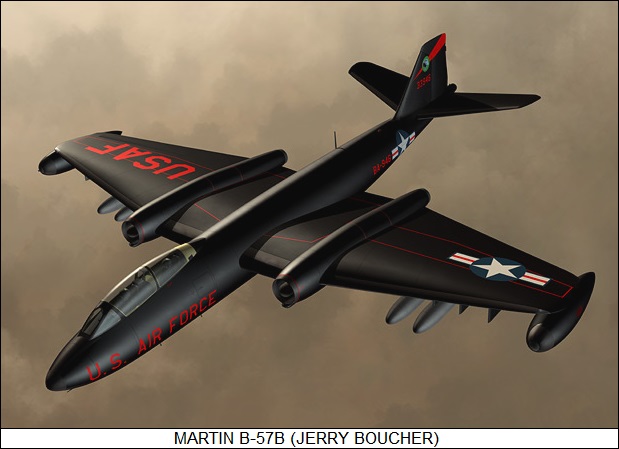
* US Air Force (USAF) observers attended the Farnborough air show in 1949 and were suitably impressed by Bee Beamont's spectacular air display of the new British Canberra bomber. That amounted to no more than a favorable impression on the Americans at the time, but after the Korean War broke out in June 1950, USAF brass quickly realized that the service required a jet tactical bomber. All the Air Force had for the tactical bombing role at the time was the Douglas B-26 Invader, which was an excellent aircraft and would also prove useful in Vietnam, but it was piston-powered and regarded as obsolescent. In addition, combat losses of the B-26 were such that the curve indicated all of them would be lost if the conflict continued into 1954.
A list of aircraft suitable to the mission was drawn up, including the North American B-45 Tornado; the North American AJ-1 Savage carrier-based bomber, a "hybrid" machine with twin piston engines and one jet engine; the Avro Canada CF-100 Canuck, a big long-range twin-jet interceptor seen as adaptable to the tactical bomber role; and the new Martin XB-51, an exotic machine with three jet engines -- one in the tail, one on pylons on either side of the nose. An American delegation also went to the UK in the summer of 1950 and was given flight demonstrations of the Canberra; the group was impressed and the Canberra was added to the list.
A competitive flight demonstration was planned to take place at Andrews Air Force Base (AFB) near Washington DC in early 1951. An RAF crew ferried the fourth production B.2, tailcode WD932, over the Atlantic on 21 February, with Beamont to do the honors at the flight demonstration on 26 February. All five candidate aircraft were to perform a given set of maneuvers in a ten-minute slot. The major competition was the XB-51, since it had been designed to USAF specifications for the tactical bomber role. The general assumption among the Air Force brass was that the Canberra might make a useful interim solution until the XB-51 entered service.
The XB-51 was the second-to-last performer, and though it was well the fastest of the lot, it was not all that maneuverable. Beamont took the final slot and put the B.2 through its required paces. He completed the set pattern in six minutes and came in for a landing -- only to perform a "touch and go", then retracting landing gear and zooming back up into the sky, performing an impressive set of unscheduled aerobatics, to then come back down and land. Beamont blew out the mainwheel tires of the aircraft on landing, not realizing that the runway had been sanded due to icy conditions, but the aircraft did not go out of control and few noticed any problem.
The Canberra was seen as the clear winner of the fly-off, but there was the problem of arranging production of the machine, so both the Canberra and the XB-51 were selected as "winners" until manufacturing issues were resolved. The main problem was that British production capacity was "maxed out" and unable to provide Canberras quickly in the quantities desired by the USAF. The end result was that the Martin company obtained a license for and assistance in production of the Canberra, with EE taking a 5% royalty, and the XB-51 was quietly forgotten. Although the US had operated British aircraft during World War II, this was the first license construction of a British combat jet aircraft in the USA.
* Martin proposed a substantially revised version of the Canberra, with swept wings and a tee tail along the lines of the XB-51, to the Air Force, but the service needed a solution quickly and the "B-57B Super Canberra" was rejected. Work on license production moved ahead, with plans flown from the UK to be converted from Imperial to metric measurements.
The Canberra flown by Beamont in the fly-off, WD932, was used as a pattern aircraft. A second pattern aircraft, the 12th production B.2 with tailcode WD940, was delivered by Beamont on 31 August 1951. On arriving at the Martin plant at Middle River, Maryland, he put on one of his awesome flight displays for the factory personnel. WD940 was used as a trials aircraft to evaluate the distinctive components of the Yank Canberra. The first pattern aircraft, WD932, was lost in an accident on 21 December 1951. Due to a fuel trim problem, the aircraft lost a wing on a turn; the pilot ejected safely, but the navigator / observer's parachute didn't open properly and he was killed.
The first "B-57A" performed its initial flight on 20 July 1953, with Martin test pilot Pat Tibbs at the controls. Beamont got a chance to fly this aircraft later and found it had no "funnies" relative to a British-built Canberra. The first Martin-built B-57A performed its initial flight on 20 July 1953. It was formally called the "Night Intruder" but that name never really stuck, and at least the public would generally refer to the aircraft as the "Canberra", like its British cousins.
BACK_TO_TOP* Only eight B-57As were built. They never entered real operational service, being used for trials and evaluations. They were hard to distinguish from the Canberra B.2 at first glance, featuring the "fishbowl" style canopy, but there were significant differences.
The engines were Americanized, sort of. Instead of the Avon 101s of the Canberra B.2, the B-57A featured more powerful Wright J65 engines, with 32.1 kN (3,275 kgp / 7,220 lbf) thrust each. They were actually license-built British Armstrong Siddeley Sapphire turbojets. The nacelles were a bit larger up front to handle the Sapphires, and there was also a distinctive airscoop for cooling air beneath the main engine intake. Originally, engine production was subcontracted to the Buick division of General Motors, with the engines designated J65-BW-5, but the Buick engines didn't prove satisfactory and production reverted to Wright, with Buick-built engines designated J65-W-5. Crew was reduced to two, with the cockpit slightly modified to provide a better view, the windows for the bombardier-navigator's coal hole rearranged, and the pitot tube moved from the front of the nose glazing to under the nose.
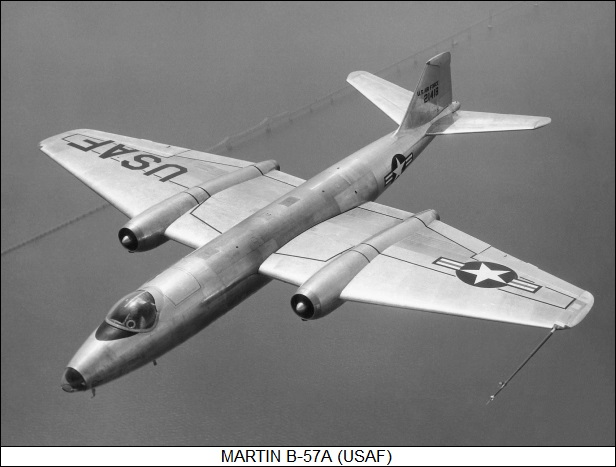
In 1957, one B-57A was passed on to the US National Advisory Committee on Aeronautics (NACA) -- the main predecessor organization to the modern US National Aeronautics & Space Administration (NASA) -- and was used for various trials as the "JB-57A". The JB-57A was ultimately passed back to Martin and continued in trials work. In 1960, another one of the B-57As ended up in the hands of the US National Oceanographic & Atmospheric Administration (NOAA), being fitted with a bulbous radar nose and flown out of Miami, Florida, for hurricane studies. There were a number of test fits of passed-on B-57s with "J" and "N" prefixes; they are of little interest and not mentioned further here.
* The first true production version of the B-57 was the "RB-57A", a photo-reconnaissance platform. It was very much the same as the B-57A and even retained the bomb bay, though it featured a reconfigurable suite of cameras aft of the bomb bay and the appropriate controls for the back-seater, the "photo-navigator". 67 were ultimately built, with the first performing its initial flight in October 1953, and the type going into service in 1954. They were delivered in an overall black color scheme, though some would serve in natural metal finish.
The RB-57A was only intended as an interim solution, the Air Force intending to obtain the Douglas RB-66B Destroyer for the reconnaissance mission, and at least early on, the RB-57A suffered from a high accident rate. RB-57As began to be pulled from first-line service in the spring of 1957, and were phased out to US Air National Guard (USANG) squadrons by the fall of 1958. That wasn't all of the story to the RB-57A, since the type was also used in secondary roles and as a basis for specialized conversions:
All the RB-57As were out of service by the early 1970s.
BACK_TO_TOP* As mentioned, the B-57As were used for trials, evaluating technologies for the definitive B-57, the "B-57B", which was a truly Americanized Canberra. The most distinctive change was fit of a new nose with a tandem fighter-type canopy featuring a rear-hinged clamshell canopy. As the British also realized, the original fishbowl canopy made low-level attack troublesome because it didn't have optically-flat surfaces; even if that hadn't been the case, the Air Force didn't like the "coal hole" arrangement, since it restricted visibility -- it was nice to have a second pair of eyes to keep a lookout in combat -- and complicated escape in an emergency. The front panel on the canopy had a windshield wiper. The new cockpit scheme was actually trialed on the surviving British pattern aircraft.
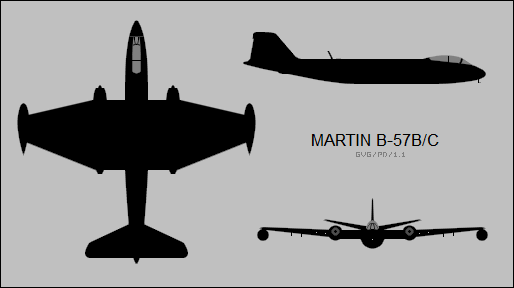
The original bomb bay doors were replaced by a rotating bomb bay door, a scheme that had been developed by Martin for the XB-51. Munitions were actually mounted on the door itself; not only did this configuration reduce buffeting and permit high-speed attacks, but it was also possible in principle to have a "bombed-up" door available at an airbase to swap into a B-57 returning from a sortie, permitting rapid turnaround. A total of 2,720 kilograms (6,000 pounds) of stores could be carried internally. A comparable rotating bomb bay scheme was used on the British Blackburn Buccaneer low-level naval strike aircraft.
There were four stores pylons under each of the B-57B's wings, for a total of eight, each capable of carrying a 225-kilogram (500-pound) bomb. That gave in principle a maximum warload of 4,500 kilograms (10,000 pounds) of munitions, but in practice the usual warload was no more than half that. Most pictures of B-57Bs with external stores show only a total of four stores pylons fitted.
The B-57B also had fixed gun armament, in the form of four M3 Browning 12.7-millimeter (0.50-caliber) machine guns in each wing, for a total of eight machine guns, with 300 rounds per gun. The cockpit featured a gunsight, of course, and the aircraft was fitted with SHORAN radio navigation system; an AN/APW-11 bombing system; and an AN/APS-54 radar warning receiver (RWR) in the tail, instead of the tail-warning radar of British Canberras. The finger-type wing airbrakes of the British Canberras were judged inadequate, and a hydraulically-actuated airbrake was fitted to each side of the rear fuselage to supplement them. The Wright J65-W-5 engines were retained, but an improved starter system was implemented, permitting electrical ignition of the pyrotechnical starter cartridges instead of manual ignition.
MARTIN B-57B: _____________________ _________________ _______________________ spec metric english _____________________ _________________ _______________________ wingspan 19.5 meters 64 feet wing area 89.23 sq_meters 960 sq_feet length 19.96 meters 65 feet 6 inches height 4.75 meters 15 feet 7 inches empty weight 11,795 kilograms 26,000 pounds max loaded weight 24,950 kilograms 55,000 pounds maximum speed 935 KPH 580 MPH / 505 KT service ceiling 14,630 meters 48,000 feet range 3,700 kilometers 2,300 MI / 2,000 NMI _____________________ _________________ _______________________
Some sources claim the B/RB-57As had the rotating bomb bay door and the wing armament, but in reality, they were only used in trials for these features -- a picture survives of an RB-57A used to evaluate the rotating door. There had been plans to fit the B-57B with wing and nacelle anti-icing systems; antiskid brakes; a drag chute; and full power boosted controls. None of these features were actually implemented.
* Initial flight of the B-57B was on 18 June 1954, with the type going into service with USAF tactical bomber squadrons before the end of the year. Some early machines were delivered in natural metal, but most were painted overall black. A total of 202 was built; from the 83rd machine on, the eight 12.7-millimeter machine guns were replaced by four Colt M39 20-millimeter revolver-type cannons, with 290 rounds per gun. There had been hopes that the cannon could be retrofitted to the earlier machines, but installing the cannon had required major changes to the wing structure, and it wasn't possible.
A total of 38 dual-control trainers, designated "B-57C", was also built, with initial flight on 30 December 1954. They were hard to tell from B-57Bs and were combat-capable, though they were really intended for conversion training, with two usually assigned to each B-57B squadron. The B-57C could be easily reconverted to a B-57B configuration. Since the B-57B and B-57C were effectively the same aircraft and were used by the same squadrons, for simplicity in the following text a general reference to the "B-57B", not referring to any specific machines, implies "B-57B & B-57C".
* The B-57B did not get off to a good start in operational service. There were reliability problems and fatal accidents; Air Force brass also didn't think the machine had quite the capabilities desired. The most dangerous faults were quickly patched up, and a three-phase improvement program was implemented:
Although the problems with the B-57B were generally ironed out, the Air Force was fixated on supersonic performance at the time, and soon regarded the type as antiquated. The B-57B began to be withdrawn to USANG squadrons in 1958. The drawdown was slow, being halted every now and then by various emergencies, but by 1964 the B-57B was on the edge of disappearing completely from Air Force combat squadrons. However, as discussed below, events in Southeast Asia were conspiring to resurrect the B-57B from the dead with a vengeance -- though most of them given a reprieve ended up falling in battle.
* A few B-57Bs were put to use in specialized applications. At least two B-57Bs were fitted with the guidance system of the Martin Matador TM-61 ground-launched cruise missile under the PARKA 65 (later HYGIENE) program, being used for training ground controllers. It is unclear if the B-57Bs could be fully controlled from the ground, or if they simply provided cockpit indicators to guide the pilot. Two B-57Bs had the nose of a Boeing BOMARC SAM grafted on up front, and were used for similar training sessions, in which the aircraft simulated SAMs.
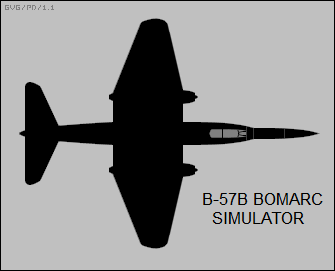
A single B-57B was passed on to NASA in the 1960s for use in various trials. One of the most interesting test programs this machine conducted was test drops of models for Viking Mars lander re-entry shells, with the models carried in the bomb bay. This aircraft featured various modifications at different times in its career, particularly an extended nose probe and a probe on each wingtip. It was retired in the 1980s. At least one B-57B was used to launch sounding rockets for high-altitude research, but it is unclear if the NASA was involved in this program.
* Pakistan was the only real (notice the qualification) foreign user of the B-57, with 24 B-57Bs and two B-57Cs passed on in 1959 under the US Military Assistance Program. From 1963, they were fitted with the RB-1A "Georgia Peach" all-weather bombing system, giving these machines a longer nose. Some of the Pakistani B-57Bs were also modified to allow them to carry four external tanks, permitting them to conduct strikes deep inside India.
Pakistani B-57Bs performed strikes during the 1965 Indo-Pakistani War, flying 167 sorties, with three lost in combat, but as mentioned destroying three IAF Canberras on the ground. They also saw combat in the brief 1971 Indo-Pakistan War, with reports of four or five lost in combat. The Pakistani B-57s remained in service well into the 1980s, being the last of the breed flying in military colors.
* A total of 68 "B-57E" target tugs was also built, with initial flight on 15 May 1956. The B-57E featured four target winches in the bomb bay and carried four sleeve targets, with two accommodated in a tube on each side of the lower rear fuselage. In practice, usually only two winches were fitted and two sleeve targets carried. The sleeve targets were not recovered after use, instead simply being cut loose. The back-seater handled the target winches. The B-57E had a number of other minor changes:
Initial flight was on 16 May 1956. As with the B-57C, the B-57E could be easily converted back to B-57B configuration. Once semi-active radar and heat-seeking AAMs became more normal armament, the Air Force had little need for a sleeve target tug, and in the early 1960s 26 B-57Es were converted to the electronic warfare training role as "EB-57Es", taking up the role from the EB-57As. Like the EB-57As, the EB-57Es were loaded up with jamming gear and had the bigger airscoops under the engine intakes to provide more cooling air.
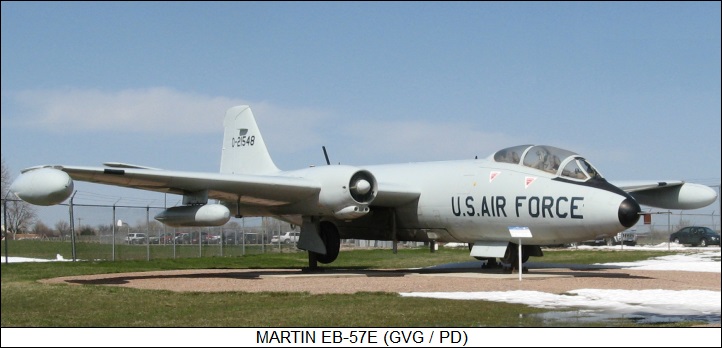
From 1963, six B-57Es were modified by General Dynamics to a night / all-weather configuration and redesignated "RB-57E". They featured an extended nose, giving them a general appearance very much like the Pakistani B-57Bs, but instead of radar, the nose carried forward oblique and panoramic film cameras. The RB-57Es also carried three cameras and a super-secret infrared scanner in the bomb bay. They were used in Vietnam under the PATRICIA LYNN program, discussed below.
BACK_TO_TOP* In the early 1950s, the US Air Force was interested in the development of a very high altitude reconnaissance aircraft. The aircraft the Air Force actually wanted would take some time to develop, and so the service wanted to obtain an interim capability to fill the gap. In 1953, the USAF awarded Martin a contract for development of a high-altitude reconnaissance version of the B-57, resulting in what was initially known as the "B-57D" but went into service as the "RB-57D". The program was codenamed BALD EAGLE.
The RB-57D featured a wing stretch from 19.51 meters (64 feet) to 32.31 meters (106 feet), as well as Pratt & Whitney J57-P-27 turbojets providing 46.7 kN (4,763 kgp / 10,500 lbf) thrust each. The bomb bay was faired over and fuselage fuel tanks were eliminated. The wing provided integral fuel tankage instead -- there was plenty of room for it, after all. Since turning an aircraft with such long wings was likely to be a chore, a hydraulically actuated rudder and yaw damper were fitted. Initial flight of the first RB-57D was on 3 November 1955, with 20 aircraft built. They were the last new-build B-57s.
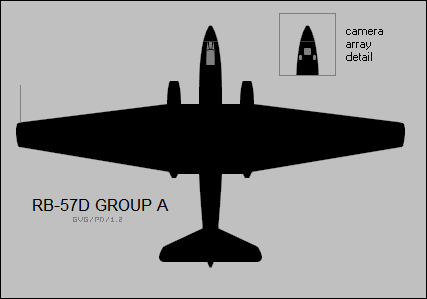
There were four different "groups" of RB-57Ds, each with different mission configurations:
All B-57Ds except Group A were fitted with an autopilot and folding rudder pedals, the last to allow a pilot to stretch his legs on a long mission. The RB-57Ds were used for covert reconnaissance flights, with missions apparently including overflights of the USSR and Red China, though details remain secret. They were also used for high altitude tests, fallout sampling, and, under the designation of "WB-57D", weather reconnaissance -- though this appears to have been in part a cover for the fallout sampling mission.
Two RB-57Ds were supplied to Taiwan in 1959 as part of a program run by the US Central Intelligence Agency (CIA) codenamed DIAMOND LIL. These two machines were painted in Nationalist Chinese markings, with white on top and black on the bottom. They were flown on overflights of Red China, with one quickly shot down on 7 October 1959 by an SA-2 SAM, the pilot being killed. The other machine remained in service until 1964. A number of RB-57Ds were also used by NASA for various high-altitude experiments.
* The RB-57D was rushed into service, and it turned out that the wings were simply not strong enough, resulting in continuous wing spar problems. The RB-57Ds were finally grounded in 1964 after one shed a wing and fell into a schoolyard -- fortunately, nobody was hurt. However, in 1966 nine retired RB-57Ds were sent back to Martin for a wing rebuild, with these aircraft crammed with electronic countermeasures gear and put to work in test and training roles. They were given the new designation of "EB-57D" and served into 1970.
Ironically, the Air Force never actually developed the full-spec high-altitude reconnaissance platform that the service had wanted. While the USAF was tinkering with that project, the CIA was working with Lockheed on a high-altitude derivative of the Lockheed F-104 Starfighter, which would emerge as the "U-2". Lockheed had tried to push the U-2 to the Air Force originally, but the USAF was focused on their own programs, and so the company went to the CIA instead. As it turned out, the U-2 would prove outstandingly successful; the Air Force dropped their own plans and adopted it as well, in fact eventually taking over all U-2 operations from the CIA.
However, the Air Force did not give up on the use of the B-57 as a high-altitude reconnaissance platform, even when the wing spar problems showed the writing was clearly on the wall for the RB-57D. In 1962, the Air Force awarded General Dynamics a contract to come up with a bigger and better B-57-based reconnaissance platform. The effort, codenamed Project PEWEE, was under the direction of the USAF "Big Safari" program office, which conducted fast-track development programs, mostly for the reconnaissance mission.
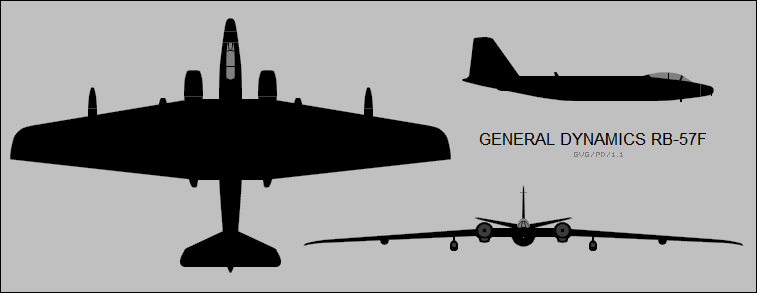
The result was the "RB-57F", with a super-stretched wing with a span of 37.31 meters (122 feet 5 inches), almost double that of the original Canberra, and Pratt & Whitney TF33-P-11A turbofan engines. The TF33 was a turbofan derivative of the J57 and provided improved fuel economy and thrust, with 73.4 kN (7,485 kgp / 16,500 lbf) per engine, about twice the thrust of the old J65s. A small Pratt & Whitney J60-P-9 booster jet with 12.9 kN (1,315 kgp / 2,900 lbf) thrust could be attached under each outer wing to increase altitude performance at some expense in range. The J60s had no starter system; they simply windmilled in the airflow and were then ignited. The RB-57F could reach at least 19,800 meters (65,000 feet).
The new wing featured three spars -- nobody wanted a repeat of the B-57D wing problems -- and a noticeable anhedral droop. There were no flaps, since getting the thing off the runway wasn't a problem; the wings only featured ailerons with trim tabs, and large spoilers in front of the ailerons to allow the aircraft to get back down on the ground. The wing featured four stores stations, though two of these were generally used for the J60 turbojets. All the fuel tankage was in the wing, with a total capacity of 15,093 liters (3,928 US gallons), leaving the fuselage free for stores. The tailfin was enlarged to improve yaw and roll stability, and many aircraft systems were modified for the cold and thin air of high-altitude flight.
Reconnaissance systems were installed where the bomb bay had been, and a new long nose was fitted for reconnaissance gear. The pilot was provided with an autopilot for long-range missions. The end result had something of a clumsy appearance and only a general resemblance to the original Canberra.
Initial flight of the first RB-57F was on 23 June 1963, with 21 built. They were in principle "upgrades" of 17 B-57Bs and 4 RB-57Ds, but in reality the assemblies from the original aircraft were a minority percentage of the machine -- it might be more accurate to think of the RB-57Fs as new-build aircraft, using some cannibalized assemblies. However, if they'd been called new-build aircraft, the Air Force would have had to pay royalties to EE.
Some RB-57Fs were used in the weather surveillance mission by the USAF Air Weather Service, with these machines redesignated "WB-57F" in 1968. Again, this seems to have been a cover for the fallout sampling mission. In WB-57F configuration, payload included four air samplers that used paper filters to pick up radioactive fallout traces; four gas samplers; three radiation meters; an ion chamber on a wing pylon; a cosmic-ray detector; a panoramic film camera; and data and voice tape recorders.
The RB-57Fs were operated on covert missions against the East Bloc. One was lost over the Black Sea on 14 December 1965 for unknown reasons. The best guess is that there was an oxygen system fault and the aircrew had suffocated, since the machine simply floated slowly out of the sky until it crashed, as if nobody was in control.
Two RB-57Fs were sent to Pakistan in 1965. They were originally sent to monitor Chinese nuclear tests and were operated by American pilots. One came back home but the other remained to perform surveillance during the 1965 Indo-Pakistan War. It was damaged by an Indian SA-2 SAM, but made it back to base to be repaired. NASA also used the RB-57F -- more on this below.
BACK_TO_TOP* Although the war in Southeast Asia had been gradually ramping up through the Kennedy Administration, under the Johnson Administration US involvement in the conflict ramped up abruptly. The B-57 became a significant component of US combat assets thrown into the war.
On 2 and 4 August 1964, there were clashes between US Navy destroyers and North Vietnamese torpedo boats, leading to reprisal airstrikes and general escalation of US actions in the war. The circumstances in this incident remain a bit murky and the "Gulf of Tonkin Incident" has been seen as at least partly a pretext for the Johnson Administration to commit US forces directly to the fighting.
Two squadrons of B-57Bs had arrived at Clark Air Base in the Philippines from Japan in April 1964, to stand by for possible deployment in Vietnam. Just before midnight on 4 August, the squadrons were ordered to Vietnam, and the aircraft departed immediately for Bien Hoa Air Base. The deployment was troublesome, to put it mildly. The first two to arrive got into a pile up on the runway, damaging each other and blocking the runway, forcing their comrades to divert to nearby Tan Son Nhut Airport; one of the damaged B-57Bs had to be written off. One of the other B-57Bs crashed on approach, with the crew killed. The difficulties were clearly due to the extreme haste in which the transfer from the Philippines was performed, the order to leave having been wrongly interpreted in a painfully traditional military screw-up as indicating a drop-dead emergency.
Things were cleaned up, and B-57Bs were soon flying missions out of Bien Hoa. They were really only there as a show of force, since by treaties in effect at the time, jet aircraft were not supposed to be used in combat in Vietnam. B-57B operations were restricted to reconnaissance, no airstrikes being conducted for the moment. The effort was clearly insignificant from a tactical point of view, and to add to the frustration of aircrews there were worries about security at Bien Hoa. South Vietnamese base security was clearly lax and the facilities were crowded, with the B-57Bs crammed together without sandbag revetments, making them easy targets.
On 1 November 1964, a mortar attack by Viet Cong insurgents destroyed five B-57Bs, damaged 15 others, and destroyed or damaged four (South) Vietnamese Air Force (VNAF) A-1 Skyraiders. Four Americans were killed and 72 wounded. Further escalations occurred and on 19 February 1965, B-57Bs flew their first strikes in the conflict, attacking Viet Cong positions near Saigon. In fact, these were the first combat bombing strikes ever performed by USAF jet bombers. On 2 March 1965, B-57Bs hit targets in North Vietnam.
In April, B-57Bs began to perform night strikes against the Ho Chi Minh trail, the enemy troop and supply lines snaking through Laos and Cambodia. The attacks were supported by transport aircraft dropping parachute flares. Similar night strikes were performed into North Vietnam, though since the air defenses there were tougher, the B-57Bs had to carry their own flares.
The B-57B force in Vietnam ran into further bad luck on 16 May 1965, when a B-57B exploded on the ground at Bien Hoa, destroying ten B-57s, eleven South Vietnamese A-1H Skyraiders, and one US Navy F-8 Crusader. 28 Americans and Vietnamese were killed, with 105 wounded. In late June, the B-57Bs were moved to Da Nang Air Base, where the facilities were better and more secure. The squadrons were restored to strength by taking B-57Bs from stateside US Air National Guard units and converting B-57E target tugs to B-57B configuration.
By the fall of 1966, the B-57Bs had been withdrawn from strikes against North Vietnam, the combat environment proving too challenging, with the load taken up by more modern Air Force combat jets. The B-57B force was relocated again to Phan Rang Air Base, where Australian Canberras would also be based come the next year, to conduct sorties "in country" and against the Ho Chi Minh trail. In some cases, US B-57Bs conducted strikes alongside the Aussie Canberra Mark 20s.
* There was a parallel effort during this timeframe to supply B-57Bs to the (South) Vietnamese Air Force (VNAF). VNAF aircrews were covertly training with USAF B-57B units at Clark AFB in the Philippines by late 1964, though the training effort was then moved to Than Son Nhut Airport. One of the B-57B students was Nguyen Cao Ky, commander of the VNAF and later president of South Vietnam.
On 1 August 1965, the VNAF B-57B effort was announced, with a number of B-57Bs painted up with VNAF insignia performing a public flypast on 9 August. A more open training program was set up at Clark. Trained VNAF aircrew then operated in Vietnam in close conjunction with USAF B-57B squadrons -- usually or always with mixed Vietnamese-American aircrews. That was really as far as it got, since for whatever reasons the Vietnamese did not like to fly the B-57B, the wind particularly going out of the sails of the effort when the VNAF officer who was most gung-ho about the program, a Major Bien, was killed on 23 February 1966 in an idiot accident. His B-57 was being pushed around a runway by ground crew; the brakes failed, the B-57 began to roll away, and he jumped out, to be run down by the machine. The program was gradually abandoned, being formally terminated in late April 1966.
* In any case, USAF B-57Bs carried on the fight in Southeast Asia. The enemy did not like them, learning to hate the distinctive shriek of the aircraft's J65 engines. One VC prisoner, on being shown silhouettes of aircraft to see which were the most feared, reacted strongly to the image of a B-57B: "The screaming bird. It is the worst. It stays over the target so long. And it never runs out of bombs." The B-57B could take a punishment as well, with pictures surviving of aircraft that made it back to base with gaping holes in a wing. The aircrews were also very competent and enthusiastic -- after all, they didn't have anything else seriously to do with their time but break things and bomb people. There was a squadron rotation scheme in which aircrews were cycled back to Clark AFB periodically to give them a rest before sending them back into combat again.
Initially, the B-57s in Vietnam had flown in natural metal colors, but quickly evolved to a color scheme with disruptive jungle camouflage on top and black on the bottom. A typical warload included nine 225-kilogram (500-pound) general purpose bombs in the bomb bay and four 340-kilogram (750-pound) general purpose bombs under the wings. Other warloads included fragmentation bombs, unguided rocket pods, napalm tanks, and "funny bombs" -- a type of thermite incendiary that dumped a cluster of submunitions over a wide area to send everything up in a sea of flames.
The B-57B kept in the action until the summer of 1969, until attrition whittled the B-57B force down to a skeleton status, and the B-57B was finally withdrawn from the conflict after years of very hard fighting. Of the 94 B-57Bs committed to combat, 51 were lost, including the 15 destroyed on the ground. Only one of the original B-57Bs sent into Vietnam in 1964 survived to 1969.
* The retirement of the B-57B from Vietnam did not mean the B-57 was no longer in combat in the theatre. Strike B-57 operations in Vietnam had been paralleled by a covert reconnaissance program codenamed PATRICIA LYNN, operating black-painted RB-57Es out of Tan Son Nhut airport. The story has it that Patricia Lynn was the name of the wife of the chief engineer assigned to the program. PATRICIA LYNN had actually been in operation for over a year before the B-57Bs arrived, with the RB-57Es performing nighttime reconnaissance missions over Laos as early as May 1963.
The RB-57Es were periodically updated with new gear. A 1968 update, under the COMPASS EAGLE program, gave the back-seater a video display to monitor the IR scanner system. That allowed the crew to call in strikes on targets in real time, instead of having to return to base to get imagery developed, by which time the enemy would have likely moved on. PATRICIA LYNN was finally ended in 1971, with the aircraft sent back to the USA and retired.
In addition, in late 1967, three B-57Bs were fitted with a "low light TV (LLTV)" system carried in an underwing pod and used in combat trials over the Ho Chi Minh Trail under a program codenamed TROPIC MOON II. This experiment going well, in 1969 16 B-57Bs were converted to a "B-57G" configuration optimized for night attack under TROPIC MOON III.
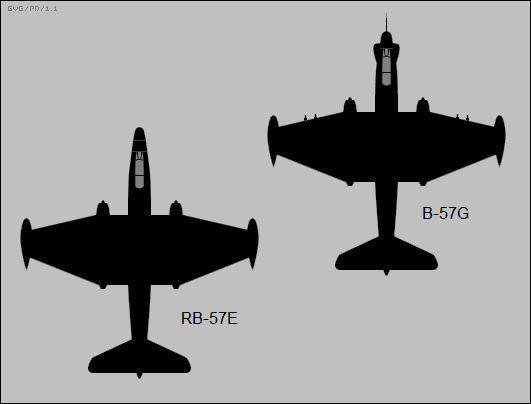
The B-57Gs seemed to be in competition with the British T.17 for the ugliest Canberra variant. The B-57Gs featured a new nose, designed by Martin, containing an AN/APQ-139 radar, an LLTV system, a forward-looking infrared (FLIR) imager, and a laser target designator for laser-guided bombs (LGBs). The back-seater monitored the sensors and handled the targeting of LGBs. The wing cannons were deleted to compensate for the added weight of the sensor system.
After trials stateside -- with one B-57G lost in a fatal crash -- eleven of the B-57Gs were deployed to Ubon Air Base in Thailand in 1970s to perform strikes on the Ho Chi Minh Trail. The other four machines remained stateside to support training. One B-57G was lost during a combat sortie, the aircrew surviving. They thought they had been hit by anti-aircraft fire, but a spotter aircraft vanished without a trace at the same time the B-57G went down, and the accident was judged a midair collision.
The B-57Gs remained in combat until the spring of 1972, but though they were very lethal when they were flying and definitely regarded as whizzy, they were troublesome to keep in the air. Vietnam was something of a proving ground for a new generation of high-tech weapons, and as is often true of "bleeding edge" technology, the high-tech systems were unreliable and hard to keep in operating condition. Given the expense of the conversions, the effort was judged as not cost-effective, and the kill rates of the Lockheed AC-130 Spectre gunship were much better than those of the B-57G.
There were trials under the PAVE GAT program, in which a tilting M61A1 20-millimeter Gatling cannon was fitted in the bomb bay of a B-57G in hopes of increasing its combat effectiveness, but it still couldn't compete with the AC-130. The B-57G did provide experience for further work on night attack technology. The survivors were passed on to the Kansas Air National Guard before being retired in 1974.
BACK_TO_TOP* The retirement of the B-57G in 1974 was effectively the end of the B-57 in the attack role for the USAF, but EB-57Es did soldier on into 1982. Their retirement ended a quarter century of B-57 service with the Air Force. A number of remain as static displays.
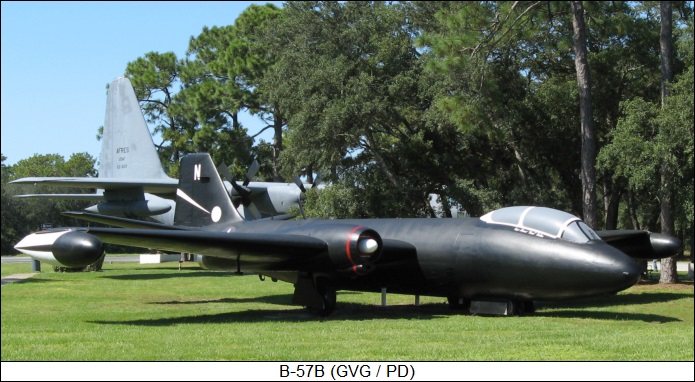
The WB-57F continued in use with the USAF Air Weather Service through most of the 1970s but was finally retired in 1974. However, NASA, which had used loaned USAF RB-57Fs in the 1960s for various tests, continued operations with the type. NASA acquired a WB-57F from the Air Force in 1972, with a second following in 1974. The first of the two was retired in 1982, ending up in the Pima Air Museum in Arizona, but the second remains in service, and was joined by a third. This machine was obtained from the Air Force by the US National Center for Atmospheric Research (NCAR) in the mid-1990s and heavily loaded up with instrumentation, but NCAR found maintaining such an old machine very troublesome, and passed it on to NASA in 1998.
NASA still had the two WB-57Fs in service in the early 21st century. When the NASA space shuttle went back to space in 2005, the flight was observed by the two WB-57Fs, fitted with a telescopic camera turret on the nose. They are regarded as excellent platforms for carrying experiments, not merely because of their payload capacity, which is greater than that of NASA's U-2 machines, but also because the WB-57Fs are two-seaters, allowing a researcher to go along for the ride and supervise experiments.
In 2012, the two WB-57F machines were back in military service, at least temporarily, acting as flying battlefield network communications hubs over Afghanistan. They were fitted with the "Battlefield Airborne Communications Node (BACN)" relay system, which not only passes on signals from one tactical communications set to another, but translates between incompatible signals formats. The WB-57Fs were used in development of BACN and went on to perform operational duties, though once other BACN platforms were in service, the WB-57Fs went back to more peaceful duties.
They don't seem to be close to retirement yet, and in fact NASA obtained a third WB-57F -- yanked from mothballs in the "boneyard" at Davis-Monthan AFB in Arizona in 2011, to be refurbished by Sierra Nevada Corporation in Colorado, and flown on to NASA in late 2013. It is unclear just how much longer they will stay in service; there is no shortage of spares for the TF33 engines for the time being, so they are not a real limiting factor.
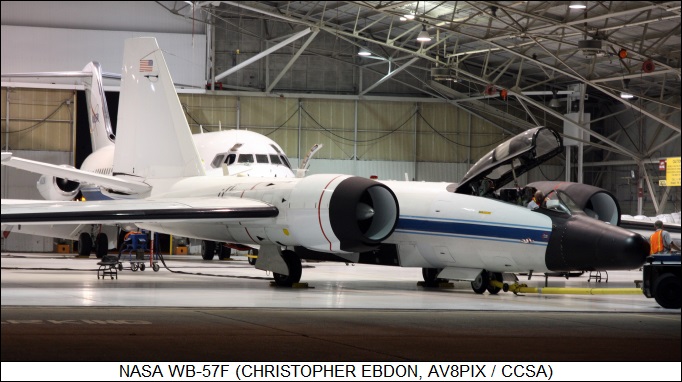
* The following table gives B-57 variants and production:
type built mod notes
________________________________________________________________________
B-57A 8 initial evaluation machines
RB-57A 67 reconnaissance platform with fishbowl canopy
RB-57A-1 - 10 LIGHTWEIGHT high-altitude reconnaissance RB-57As
RB-57A-2 - 2 RB-57As with AN/APS-60 radar
EB-57A - 24 EW training machines
B-57B 202 12 definitive attack B-57
B-57C 38 dual-control B-57B
B-57D 20 long-wing high-altitude reconnaissance configuration
WB-57D - 3 B-57Ds in atmospheric sampling role
EB-57D - 9 B-57Ds refurbished as EW trainers
B-57E 68 target tugs
EB-57E - 26 EW training machines
RB-57E - 6 Night reconnaissance conversions
RB-57F - 21 ultra-long wing high-altitude recce configuration
WB-57F - ? B-57Fs in atmospheric sampling role
B-57G - 16 B-57Bs converted to night attack role
________________________________________________________________________
403 TOTAL B-57 PRODUCTION
939 TOTAL UK CANBERRA PRODUCTION
48 TOTAL AUSTRALIA MARK 20 CANBERRA PRODUCTION
________________________________________________________________________
1,390 TOTAL CANBERRA PRODUCTION
________________________________________________________________________
BACK_TO_TOP
* I have never seen a British-built Canberra, even in a museum, but I used to see USAF Canberras every rare now and then in the late 1960s, flying over my hometown of Spokane, Washington, in transit to someplace else. They were painted in Vietnam-style jungle camouflage, with black undersides and disruptive camouflage patterning on top. I now live in Loveland, Colorado, not far from Boulder where NCAR is sited, and I had the memorable experience in the mid-1990s of seeing the NCAR WB-57F fly very low almost over my head one afternoon.
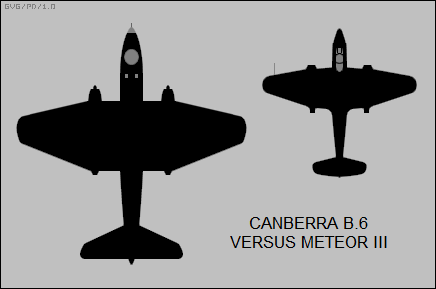
* As concerns copyrights and permissions for this document, all illustrations and images credited to me are public domain. I reserve all rights to my writings. However, if anyone does want to make use of my writings, just contact me, and we can chat about it. I'm lenient in giving permissions, usually on the basis of being properly credited.
* Sources include:
Some details on the B-57 were obtained from an online document by aviation enthusiast Joe Baugher.
* Revision history:
v1.0.0 / 01 dec 07 v1.0.1 / 01 jan 08 / Minor corrections. v1.0.2 / 01 dec 09 / Review & polish. v1.0.3 / 01 nov 11 / Review & polish. v1.0.4 / 01 oct 13 / Review & polish. v1.0.5 / 01 sep 15 / Review & polish. v1.0.6 / 01 aug 17 / Review & polish. v1.0.7 / 01 jul 19 / Review & polish. v1.0.8 / 01 jun 21 / Review & polish.BACK_TO_TOP
